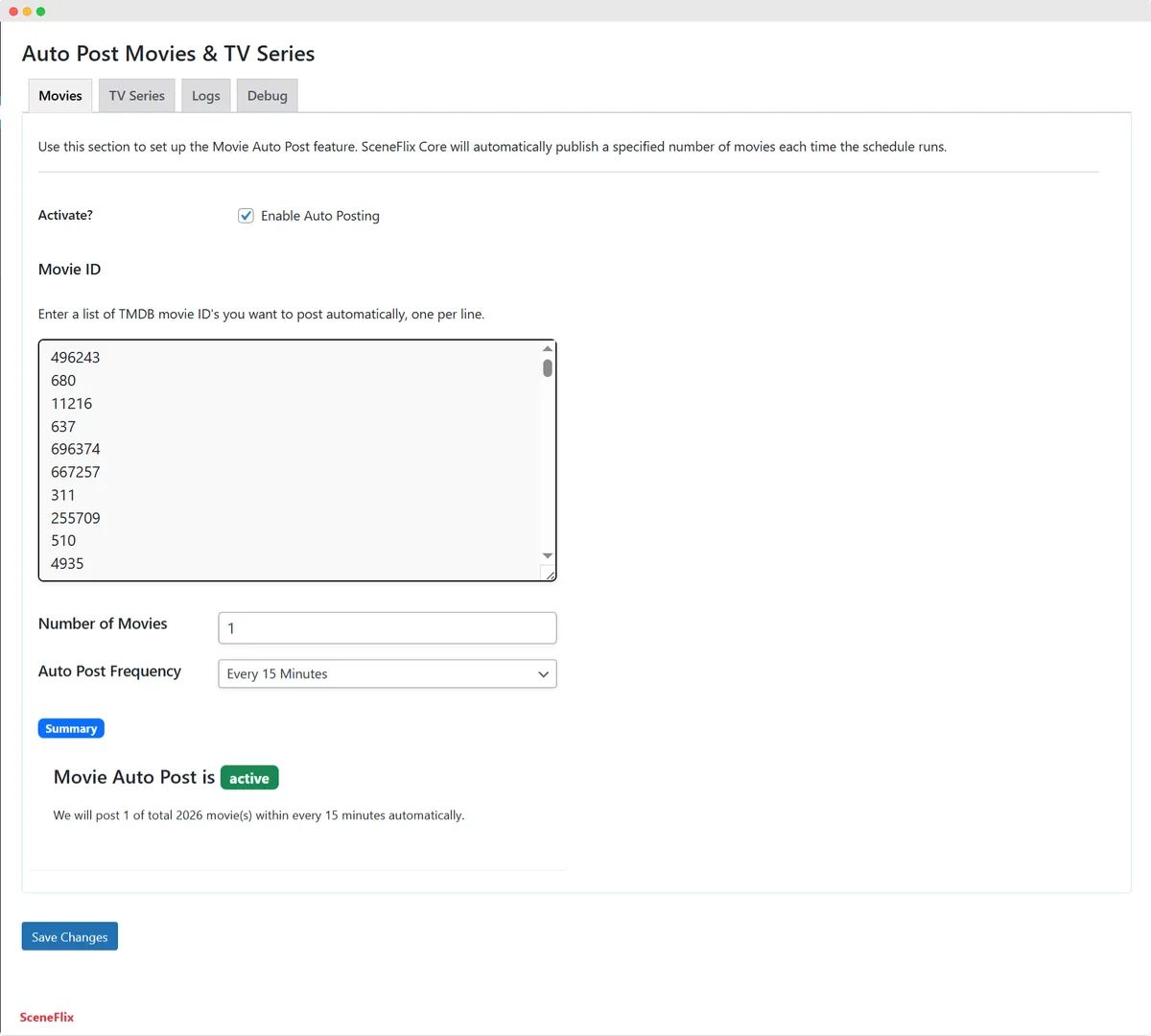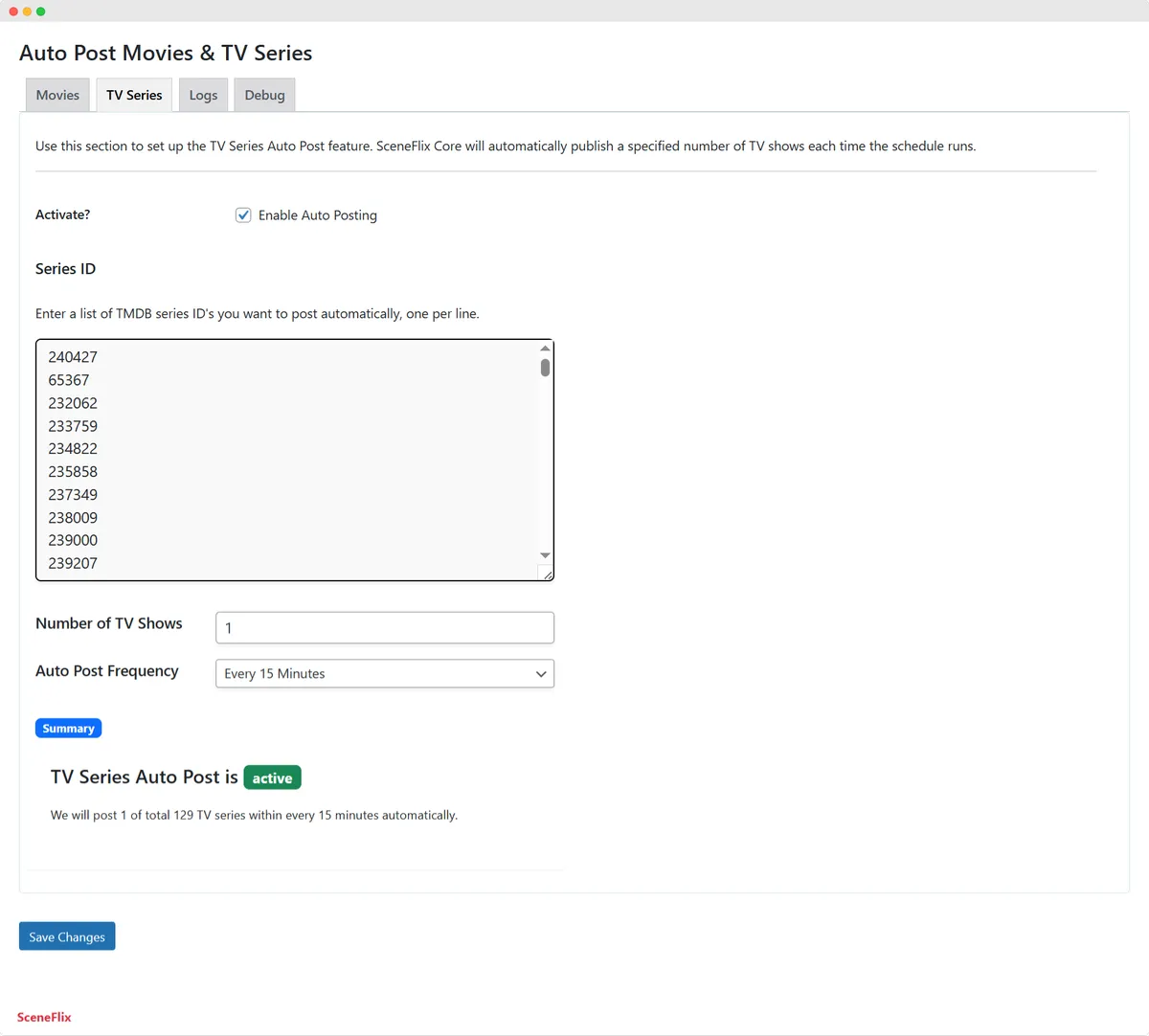The Auto Post feature is SceneFlix’s most powerful automation tool, designed to automatically create movie and TV show posts on your WordPress site at scheduled intervals.
This feature eliminates the need for manual content creation by processing lists of TMDB IDs and automatically generating rich, detailed posts with complete metadata, images, and taxonomies.
What is SceneFlix Movies and TV Shows Auto Post?

Auto Post is an intelligent content automation system that uses WordPress cron jobs to automatically fetch movie and TV show data from TMDB and create posts on your site.
You can schedule automatic posting at various intervals ranging from every 15 minutes to every 24 hours, making it perfect for maintaining an active, regularly updated entertainment website.
How Auto Post Works
The Auto Post system in SceneFlix operates through a sophisticated workflow:
- ID Queue Management – You provide lists of TMDB IDs for movies and TV shows one per line in their respective text area fields
- Cron Job Scheduling – WordPress cron jobs run at your specified intervals
- License Validation – Each execution validates your SceneFlix license
- Data Processing – The system fetches data from TMDB and creates posts
- Queue Management – Successfully posted IDs are removed from the queue
- Status Tracking – All operations are logged and tracked in the database
Setting Up Auto Post
Prerequisites
Before setting up Auto Post, ensure you have:
- Active SceneFlix License – Auto Post requires a valid license
- TMDB API Key – At least one configured API key
- TMDB ID Lists – Lists of movie and TV show IDs to process
- WordPress Cron – Ensure WordPress cron is functioning properly
Accessing Auto Post Settings
- Navigate to SFCore Menu – Go to the SceneFlix admin panel
- Find Auto Post Settings – Look for movie and TV show auto-post options
- Configure Settings – Set up your posting preferences
Auto Post Configuration
Movie Auto Post Settings

Activation Checkbox
- Enable/disable movie auto-posting
- Must be activated for cron jobs to run
Posting Frequency
- Every 15 Minutes
- Every 30 Minutes
- Every 3 Hours
- Every 6 Hours
- Every 12 Hours
- Every 18 Hours
- Every 24 Hours (Daily)
Number of Movies per Execution
- Configure how many movies to process in each cron run
- Prevents server overload and API rate limits
- Typical range: 1-5 movies per execution
Movie ID List
- Textarea containing TMDB movie IDs
- One ID per line
- IDs are automatically removed after successful posting
TV Show Auto Post Settings

Activation Checkbox
- Enable/disable TV show auto-posting
- Independent from movie auto-post settings
Posting Frequency
- Same interval options as movies
- Can be set to different frequency than movies
Number of Series per Execution
- Configure how many TV shows to process per run
- Considers the complexity of TV show data (seasons, episodes)
Series ID List
- Textarea containing TMDB TV show IDs
- One ID per line
- Automatically managed like movie IDs
Advanced Cron Management
Custom Cron Intervals
SceneFlix registers custom cron intervals for flexible scheduling:
// Available intervals
'fifteen_minutes' => 15 * MINUTE_IN_SECONDS
'thirty_minutes' => 30 * MINUTE_IN_SECONDS
'three_hours' => 3 * HOUR_IN_SECONDS
'six_hours' => 6 * HOUR_IN_SECONDS
'twelve_hours' => 12 * HOUR_IN_SECONDS
'eighteen_hours' => 18 * HOUR_IN_SECONDS
'daily' => 24 * HOUR_IN_SECONDS
Cron Job Validation
The system includes sophisticated cron validation:
- Automatic Rescheduling – If settings change, cron jobs are automatically rescheduled
- Frequency Tracking – The system tracks current vs. scheduled frequencies
- Duplicate Prevention – Prevents multiple cron jobs for the same task
- License Validation – Each execution validates license status
- Error Recovery – Daily checks ensure cron jobs remain active
Status Tracking System

Database Tables
sceneflix_status Table
- Tracks processing status of all IDs
post_statusvalues:0= Not processed1= Successfully processed2= Failed processing
post_type= ‘movie’ or ‘tv’tmdb_id= TMDB identifier
sceneflix_movies Table
- Stores movie-specific information
- Links TMDB IDs to WordPress posts
- Contains title, URL, TMDB ID, IMDB ID
sceneflix_series Table
- Stores TV show-specific information
- Similar structure to movies table
- Tracks series posts and metadata
Processing Status
Successful Processing
- Post created successfully
- Status set to 1
- ID removed from queue
- Added to respective content table
Failed Processing
- Post creation failed
- Status set to 2
- ID remains in queue for retry
- Error logged for debugging
Error Handling and Logging
Comprehensive Logging
The Auto Post system includes extensive logging:
error_log('SceneFlix: Movie auto-post cron job started');
error_log('SceneFlix: Processing movie ID: ' . $id);
error_log('SceneFlix: Successfully processed movie ID: ' . $id);
error_log('SceneFlix: Movie auto-post completed');
Error Recovery
- API Failures – Handles TMDB API connection issues
- Data Validation – Skips incomplete or invalid data
- Image Download – Graceful handling of image failures
- Database Errors – Proper error handling for database operations
- License Issues – Stops processing if license is invalid
Debugging Features

- Debug URL –
?sceneflix_debug_cron=1shows cron status - Manual Triggers – Test cron jobs manually
- Status Monitoring – Check next scheduled execution times
- Queue Inspection – View remaining IDs in queue
Best Practices
Frequency Selection
High-Traffic Sites
- Use longer intervals (6+ hours)
- Process fewer items per execution
- Monitor server resources
New Sites
- Start with shorter intervals (1-3 hours)
- Process more items to build content quickly
- Adjust based on performance
Queue Management
Optimal Queue Size
- Maintain 50-200 IDs in queue
- Avoid extremely large queues
- Regular queue monitoring
ID Quality
- Verify TMDB IDs before adding
- Remove invalid or duplicate IDs
- Test with small batches first
Performance Optimization
Server Resources
- Monitor CPU and memory usage
- Adjust frequency based on server capacity
- Consider peak traffic times
API Rate Limits
- Don’t exceed TMDB API limits
- Use multiple API keys if needed
- Implement proper delays
Troubleshooting
Common Issues
Cron Jobs Not Running
- Check WordPress cron functionality
- Verify hosting provider allows cron
- Use debug URL to check status
Posts Not Creating
- Verify license activation
- Check TMDB API key validity
- Review error logs for specific failures
Queue Not Processing
- Confirm auto-post activation
- Check frequency settings
- Verify ID format and validity
Debug Tools
Cron Debug Page
?sceneflix_debug_cron=1
Shows comprehensive cron status information
Manual Triggers
?sceneflix_test_movie_cron=1
?sceneflix_test_series_cron=1
Manually trigger auto-post for testing
Force Reschedule
?sceneflix_reschedule_cron=1
Force cron job rescheduling
Performance Monitoring
- Server Logs – Monitor for PHP errors or timeouts
- WordPress Logs – Check for cron-related issues
- Database Performance – Monitor query execution times
- API Response Times – Track TMDB API performance
Advanced Configuration
Multiple API Keys
Use multiple TMDB API keys for better rate limiting:
- Add keys line by line in settings
- System randomly selects keys
- Distributes API load effectively
Custom Intervals
For hosting providers with different cron capabilities:
- Modify cron intervals in code
- Adjust based on server specifications
- Consider peak traffic patterns
Batch Size Optimization
Small Batches (1-2 items)
- Lower server load
- More frequent updates
- Better error isolation
Large Batches (3-5 items)
- Faster content creation
- More efficient processing
- Higher server requirements
Monitoring and Maintenance
Regular Monitoring
Daily Checks
- Verify cron jobs are running
- Check queue levels
- Monitor error logs
Weekly Reviews
- Analyze processing statistics
- Adjust frequencies if needed
- Clean up failed entries
Maintenance Tasks
Queue Cleanup
- Remove invalid IDs
- Update failed entries
- Maintain optimal queue size
Performance Tuning
- Adjust intervals based on traffic
- Monitor server resources
- Optimize batch sizes
Integration with Manual Features
Relationship with Manual Tools
- Manual Override – Manually created posts are respected
- Queue Priority – Manual posts take precedence
- Status Synchronization – Manual and auto posts share status tracking
Hybrid Workflow
- Auto Post for Volume – Use auto-post for bulk content
- Manual for Specials – Manually create featured content
- Queue Management – Remove manually created IDs from queue
Conclusion
The Auto Post feature transforms SceneFlix into a powerful content automation platform. By properly configuring frequencies, managing queues, and monitoring performance, you can maintain an active, regularly updated entertainment website with minimal manual intervention.
The system’s robust error handling, comprehensive logging, and flexible scheduling options make it suitable for websites of all sizes, from small blogs to large entertainment portals. Regular monitoring and maintenance ensure optimal performance and reliable content creation.
